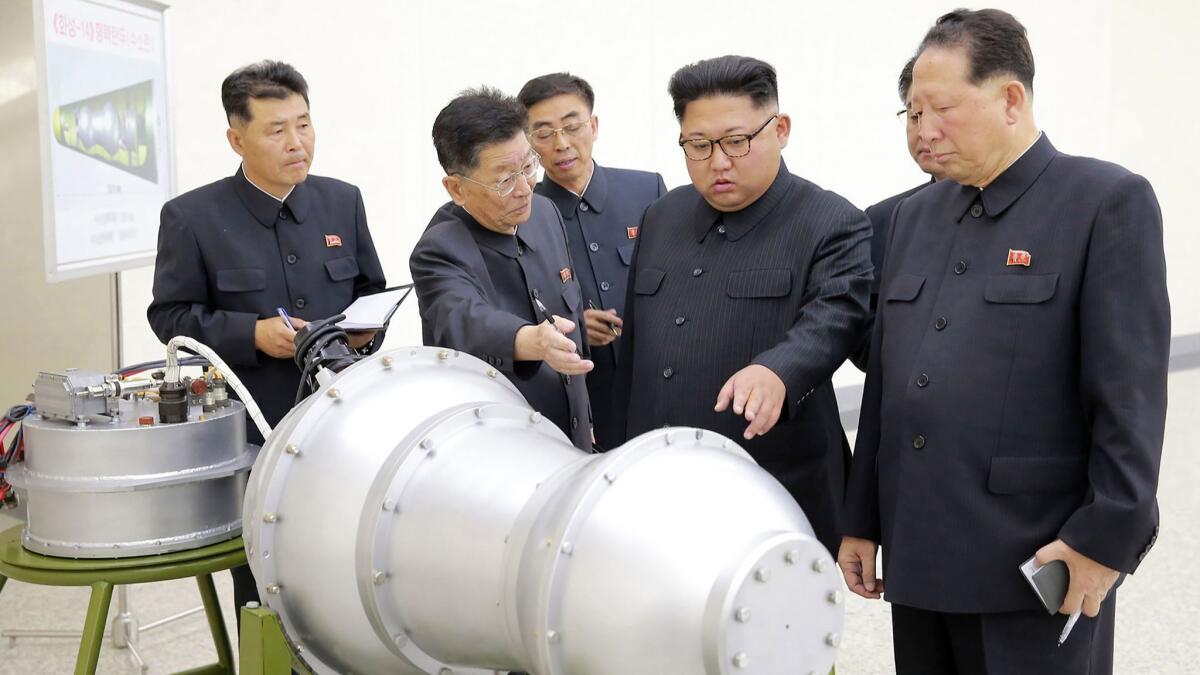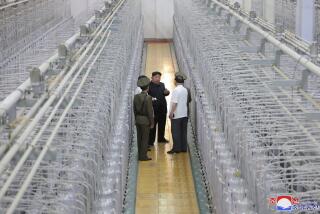A nuclear deal with North Korea would require unprecedented access to secret weapons sites

- Share via
Reporting from Washington — President Trump wants North Korea to do something unprecedented in the history of arms control — to reveal all the secrets of a vast nuclear weapons complex it has spent decades concealing and billions to build.
No one expects that kind of breakthrough when Trump sits down with North Korean leader Kim Jong Un on June 12 in Singapore. Even Trump has acknowledged the summit will start “a process.”
But if Kim subsequently agrees to disarm in stages over the next decade or longer, the most likely outcome if a nuclear deal ultimately is struck, the massive effort would require hundreds of international nuclear inspectors to help dismantle warheads, shut down facilities, interview North Korean scientists, unravel procurement systems, physically tag and monitor bomb-making equipment, and do much more.
At this point, not enough nuclear experts may exist to visit the hundreds of buildings, track down the voluminous records and conduct the comprehensive inspections required to verify compliance. Nothing approaching such a sweeping agreement with a closed police state like North Korea has been attempted in the history of nuclear disarmament.
“This situation is without precedent,” said Daryl Kimball, a nonproliferation expert with the Arms Control Assn., a Washington policy organization. “No country that has openly conducted test explosions and amassed a nuclear arsenal as North Korea has done has ever willingly eliminated its stockpile.”
U.S. intelligence agencies believe Pyongyang has assembled as many as 60 nuclear weapons and built a widely dispersed network of secret development and production facilities, some deep underground in the country’s rugged northern mountains, to create fissile material and testing components, and to assemble and store the actual warheads.
As part of any deal, U.S. officials also are likely to seek restrictions on North Korea’s ballistic missiles, especially those capable of hitting U.S. soil. Additional outside experts thus would be needed to inspect missile factories and test sites.
No matter how intrusive the inspections, there would be almost no way to guarantee North Korea wasn’t concealing a stash of components or a fully assembled warhead in case Kim or his successors faced a future threat to their survival, former officials and inspectors said.
“Say they declare 30 nukes. Can you verify 30? Yes,” said Robert Gallucci, who led 1994 talks with North Korea for the Clinton administration and is a professor at Georgetown University. “Can we ever, ever be certain they don’t have five other nukes somewhere? Absolutely not.”
If an accord with North Korea is struck, Pyongyang probably first would be required to submit a full accounting of its nuclear program — back to the beginning — to the International Atomic Energy Agency, the United Nations’ nuclear watchdog agency based in Vienna. That would be followed by comprehensive IAEA inspections aimed at confirming — or disproving — details in the documents.
Given the scale of Pyongyang’s program, the IAEA would need to hire and train a major new workforce and build or buy sophisticated monitoring equipment, from sensors to cameras, to ensure North Korea doesn’t cheat. The agency also would need the U.N. Security Council to approve the operation and fund it with a budget increase.
The IAEA said last year it had about 300 inspectors, including 80 who are working to monitor Iran’s 27 mostly dormant nuclear facilities as part of the 2015 nuclear accord that Trump abandoned last month. Iran and the other signatories are still honoring the agreement.
North Korea, by contrast, is believed to have up to 100 clandestine sites, according to a report by Rand Corp., a think tank based in Santa Monica. And Iran never built any nuclear weapons or intercontinental ballistic missiles.
Trump administration officials say their goal is complete, verifiable and irreversible disarmament, a high bar in a country that has pursued nuclear weapons for decades and on a far larger scale than Iran, Iraq, Libya and South Africa ever did. Those countries all gave up or were forced to give up their nuclear programs.
South Africa may be the closest parallel. It dismantled its arsenal in 1989, the only country ever to give up nuclear arms that it had developed itself, as it prepared to move from apartheid to black majority rule. But its program was tiny compared to North Korea’s.
South Africa “dismantled on their own in secret, then only later admitted to having a program,” said Frank Pabian, a former IAEA inspector and retired nonproliferation expert. “North Korea is a declared nuclear weapons state. That’s why I’m not optimistic.”
IAEA inspectors last arrived at North Korea’s main nuclear complex at Yongbyon, north of Pyongyang, in 2007. All international inspectors were expelled in 2009 when North Korea pulled out of so-called six-party talks in Beijing and resumed its nuclear enrichment program.
Any inspectors sent to North Korea would not be operating completely in the dark, however.
They presumably would have access to IAEA reports, satellite surveillance and intelligence from the U.S. and other countries about known and suspected nuclear facilities, identities of key scientists to interview, information from defectors, and even reports from experts allowed to visit key sites.
Siegfried Hecker, a former director of the nuclear weapons laboratory at Los Alamos, N.M., has toured North Korea’s major nuclear facilities four times and is the only U.S. scientist to visit its facility for enriching uranium, a bomb fuel. U.S. intelligence agencies had not spotted its construction.
A new study on the issue that Hecker coauthored with fellow Stanford University researchers Robert Carlin and Elliot Serbin warns that “in the short term, North Korea will surely hedge its bets by retaining parts of the program.”
Uranium enrichment facilities “would be problematic,” they wrote. “North Korea has covert facilities that it is unlikely to declare and eliminate initially.”
Rather than pushing for a swift disarmament, the report suggests small, achievable steps, including a continued freeze on nuclear and ballistic missile tests and a shut-down of the enrichment facility at Yongbyon. It might take six to 10 years of phased concessions on both sides before the nuclear risk is substantially eliminated.
Even if Pyongyang cooperated initially with the inspectors, it is likely to ratchet its compliance up and down, seeking leverage over the U.S. and others rivals in the region, experts said.
If the IAEA gains access to North Korean records, it may be able to determine how much fissile material it has produced. That could lead to a more precise understanding about how many operational nuclear devices Pyongyang has built.
Dismantling the warheads probably would be carried out by North Korean scientists, monitored by experts from other nuclear powers, possibly including the United States, which has extensive experience in disassembling warheads. The IAEA doesn’t have that expertise and Hecker warns that shipping them out of the country “is naive and dangerous.”
To ensure Pyonyang cannot rebuild its warheads, the U.S. may push for taking fissile material out of North Korea permanently. But after decades of working to acquire fuel for nuclear weapons, Pyongyang would almost certainly balk at giving it up.
In that case, fissile material might have to be stored in North Korea, in sealed facilities subject to IAEA monitoring.
“We would be happy to have a situation where we thought we had accounted for 90% of North Korea’s nuclear capability,” said Gary Samore, an arms control official in the Obama and Clinton administrations who now heads the Belfer Center for Science and International Affairs at Harvard University. “Even if there was a possibility they had salted away a couple of nuclear weapons for a rainy day that would be a huge achievement.”
Twitter: @davidcloudLAT
More to Read
Sign up for Essential California
The most important California stories and recommendations in your inbox every morning.
You may occasionally receive promotional content from the Los Angeles Times.











